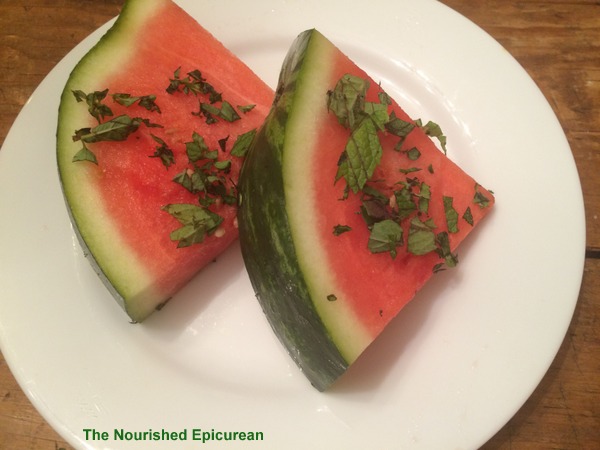Watermelon is a delicious and detoxifying warm weather food that deserves recognition for its many health-promoting properties. A welcome finale at the end of any summer meal, it’s also the easiest, fuss-free dessert you’ll ever serve!
Naturally sweet-tasting, yet crisp and refreshing, watermelon is an extremely hydrating “wet” food, about 92% water. Like other high water foods, such as cucumbers, radishes, broccoli and spinach, watermelon can help detoxify the body of excess water and fluids, providing relief from bloating.
Despite its sweet taste and a relatively high glycemic index (72), watermelon has a low glycemic load of 5. The glycemic index represents how “sugary” a food is. The glycemic load, however, is a more accurate measure because it takes into account the quality and amount of carbohydrate in a food. Because watermelon has a high water content and it is low in carbohydrates (just 5 grams carbs per serving), its impact on blood glucose levels is minimal. In other words, eating watermelon won’t give you the kind of sugar high that has you “crashing” an hour later, feeling fatigued and/or hungry for more sugar.
As someone who is sensitive to sugar, including fruit sugar (I eat fruit on very rare occasions), I can attest that watermelon does not affect my blood sugar. And, as much as I love watermelon, I find it hard to overeat—you will reach a water-logged saturation point!
Tomatoes are famous for containing lycopene, a carotenoid phytonutrient associated with reduced risk of stroke and prostate cancer. But watermelon contains even more lycopene than tomatoes.
And the cancer-fighting effects of lycopene in watermelon get a big boost from the high levels of Vitamin C and Vitamin A (antioxidants that fight free radicals) that it contains. It’s also rich in potassium, a mineral and electrolyte that helps regulate blood pressure.
The beauty of watermelon is that you don’t have to do anything to it. I love watermelon in its most natural state—right off the rind—not in a sugar-infused cocktail, smoothie, sorbet or popsicle!
Adding a little Celtic sea salt enhances its natural sweetness. My favorite way to eat watermelon? Sprinkled with a smattering of chopped fresh herbs—mint, tarragon or basil—from the garden or local farmers’ market.

How to choose watermelon
Since I have bought some dud watermelon in my time (soggy, flat-tasting or overripe, past their expiration date), I keep the following in mind when choosing:
1. A whole, uncut watermelon should feel heavy for its size (if it’s ripe) since increased water content—potentially 90% or more—accounts for the weight of a fully ripened watermelon.
2. The rind should be smooth with a dulled “top”, the side that is opposite of the spot, or, “underbelly”, where the watermelon would have been resting on the ground. If fully ripened, the ground spot will be a creamy yellow—not white or green.
3. A fully ripened watermelon is purported to have a deeper, more hollow sound when you thump it.
4. If you’re buying pre-cut watermelon, choose deeply colored flesh without any white streaking.


